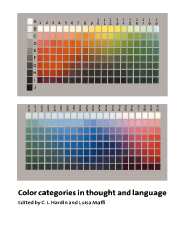Book contents
- Frontmatter
- Contents
- Notes on contributors
- 1 Introduction
- I THE WORLD COLOR SURVEY
- II VISUAL PSYCHOLOGISTS
- III ANTHROPOLOGISTS AND LINGUISTS
- 9 Establishing basic color terms: measures and techniques
- 10 Color shift: evolution of English color terms from brightness to hue
- 11 Two observations on culture contact and the Japanese color nomenclature system
- 12 Skewing and darkening: dynamics of the Cool category
- 13 Genes, opsins, neurons, and color categories: closing the gaps
- IV DISSENTING VOICES
- 16 Closing thoughts
- Subject index
- Author index
12 - Skewing and darkening: dynamics of the Cool category
Published online by Cambridge University Press: 20 August 2009
- Frontmatter
- Contents
- Notes on contributors
- 1 Introduction
- I THE WORLD COLOR SURVEY
- II VISUAL PSYCHOLOGISTS
- III ANTHROPOLOGISTS AND LINGUISTS
- 9 Establishing basic color terms: measures and techniques
- 10 Color shift: evolution of English color terms from brightness to hue
- 11 Two observations on culture contact and the Japanese color nomenclature system
- 12 Skewing and darkening: dynamics of the Cool category
- 13 Genes, opsins, neurons, and color categories: closing the gaps
- IV DISSENTING VOICES
- 16 Closing thoughts
- Subject index
- Author index
Summary
Introduction
How to demonstrate briefly my means of modeling color categorization? First, I review how category mapping procedures improve data. Next, I sketch a particular model and its rationale. Then, I display and discuss correspondences between different data, such as those between category mapping configurations and focus placements, that suggest how neurally grounded sensations and selective attention upon them may dynamically constitute a color category. Last, I appeal to this framework for an explanation of differences in the aggregate patterns of foci chosen for the so-called “cool” category by speakers of Mesoamerican languages versus speakers of languages elsewhere throughout the world. The cool category, which encompasses pure green and pure blue, is widespread among languages. Data derive from my Mesoamerican Color Survey (MCS) and the World Color Survey (WCS) of Kay, Berlin, and Merrifield (1991a, 1991b; Kay, Berlin, Maffi, and Merrifield this volume).
Equipment for the MCS was generously supplied by Kay, Berlin, and Merrifield after they ended their WCS. It consists of 330 loose randomized chips plus a miniature version of them affixed to a flat, rectangular array with green near the center. This display orders chips by their positions within the spectrum, breaking its continuous band among reds at each end. I added a red-centered array so that the artificial break would not influence subject response involving reddish categories. Most elicitations took place in shade near sun, a few at night under a 100-watt incandescent bulb.
- Type
- Chapter
- Information
- Color Categories in Thought and Language , pp. 261 - 282Publisher: Cambridge University PressPrint publication year: 1997
- 6
- Cited by



